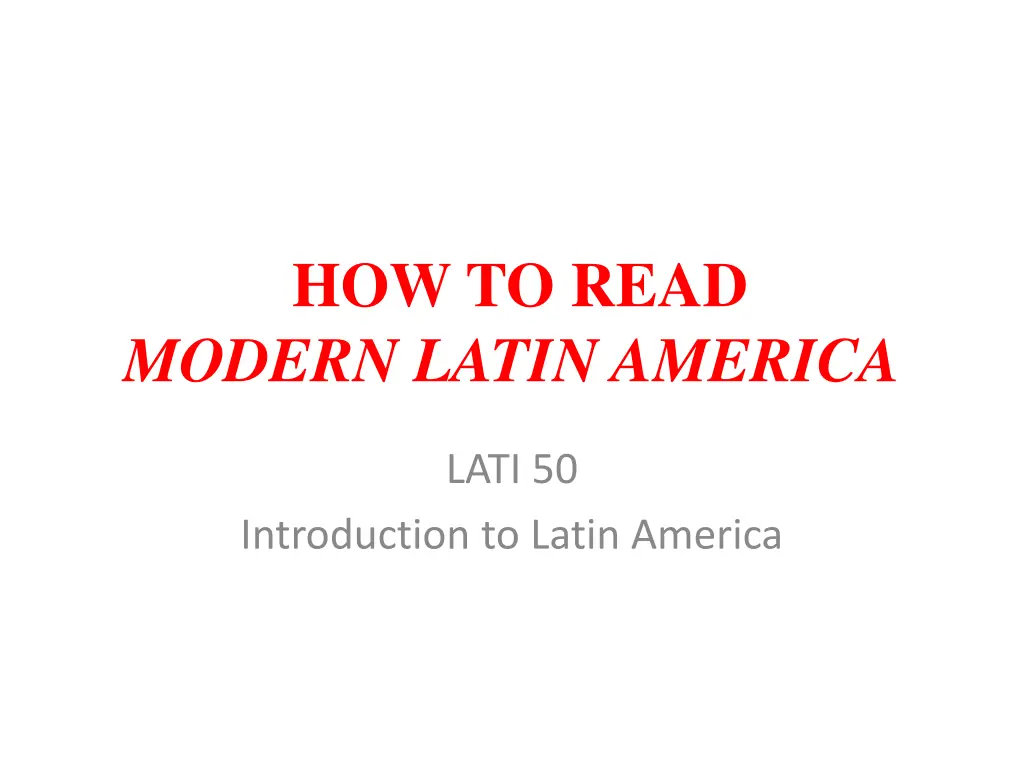
Understanding Modern Latin America: An Introduction to History and Social Structures
Explore the intricate history and social structures of Latin America with a focus on key countries like Mexico, Cuba, and Brazil. Delve into economic transformations, political consequences, and social changes that have shaped the region over time. Analyze the evolution of class groups, national institutions, and external influences on Latin American countries. Discover the chronology of change from the Liberal Era to Neoliberalism, and examine political comparisons across different nations in the region.
Download Presentation

Please find below an Image/Link to download the presentation.
The content on the website is provided AS IS for your information and personal use only. It may not be sold, licensed, or shared on other websites without obtaining consent from the author. If you encounter any issues during the download, it is possible that the publisher has removed the file from their server.
You are allowed to download the files provided on this website for personal or commercial use, subject to the condition that they are used lawfully. All files are the property of their respective owners.
The content on the website is provided AS IS for your information and personal use only. It may not be sold, licensed, or shared on other websites without obtaining consent from the author.
E N D
Presentation Transcript
HOW TO READ MODERN LATIN AMERICA LATI 50 Introduction to Latin America
CASE STUDIES Mexico: The Taming of a Revolution Central America and the Caribbean: Within the U.S. Orbit Cuba: Key Colony, Socialist State The Andes: Soldiers, Oligarchs, and Indians Colombia: Civility and Violence Venezuela: The Perils of Prosperity Argentina: Progress and Stalemate Chile: Repression and Democracy Brazil: The Awakening Giant
ANALYTICAL THEMES economic transformations induce social changes which, in turn, lead to political consequences shifting alliances among social class groups give shape to patterns of political conflict over time a country s place in the international division of labor defines the shape of available paths to economic growth differences in economic processes have produced different forms of social structure and patterns of social change
SOCIAL STRUCTURE Upper Class: Urban (industrialists, bankers) Rural (landowners) Middle Class: Urban (merchants, lawyers, etc.) Rural (small farmers) Popular/Lower Class: Urban (workers) Rural (peasants, campesinos) National Institutions: State (including military) Church External Sector: Economic (investors, merchants) Political (foreign governments)
CHRONOLOGY OF CHANGE Liberal Era (1880s-1920s) Export-import development Oligarchs and strong men Import-Substitution Industrialization (1930s-1970s) Industrialization Populism and dictatorship Socialist Alternative (1950s-1980s) Revolutionary movements State-controlled economies Neoliberalism (1980s-present) Pro-market policies Democracy (of sorts)
COMPARING POLITICS Mexico: Revolution of 1910 + dominant-party system Central America and Caribbean: plantation society, U.S. influence, dictatorship and protest Cuba: plantation society, socialist revolution, resistance to United States Question A: Compare Mexican and Cuban revolutions Question B: Trace colonial legacies in Mexico and CA + Caribbean Question C: Why not more revolution ferment in CA + Caribbean?
THE MLA WEBSITE Address: <www.oup.com/us/skidmore> Overall structure Documents 3 and 6 (#10 optional)
